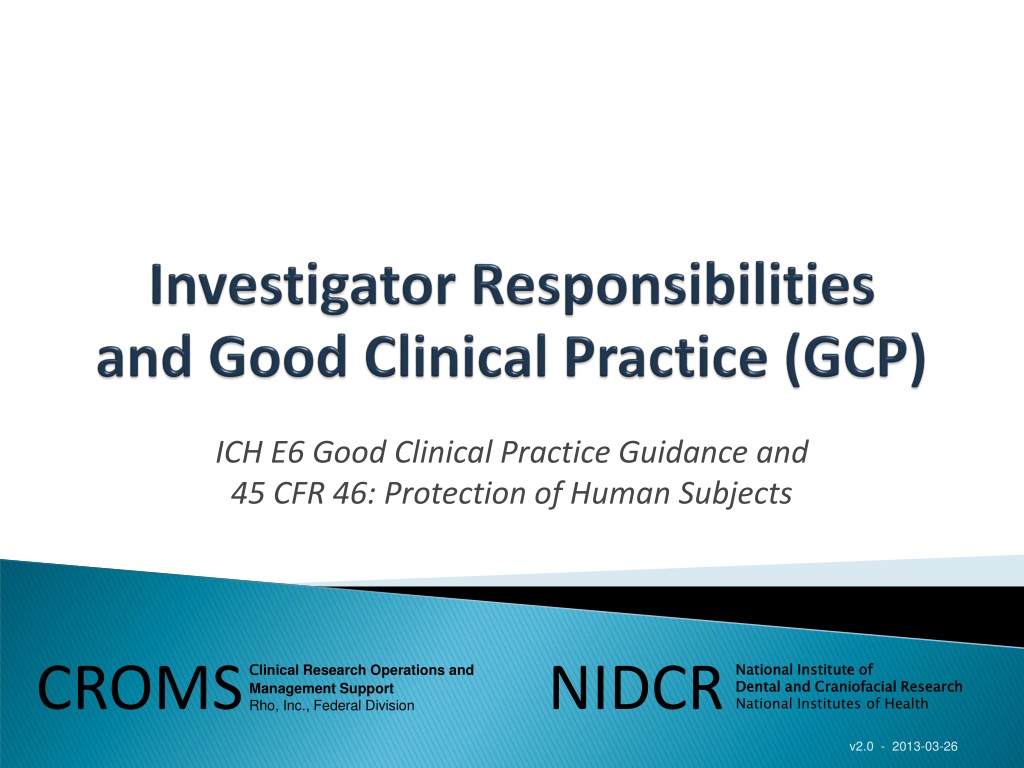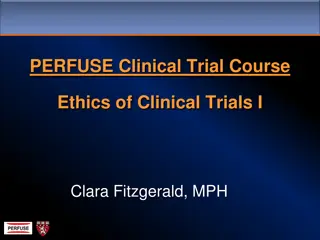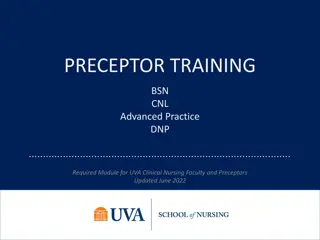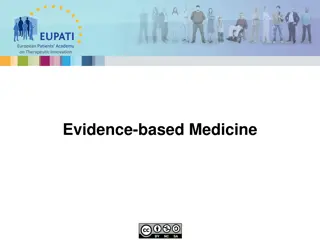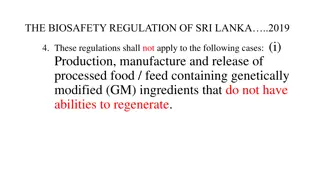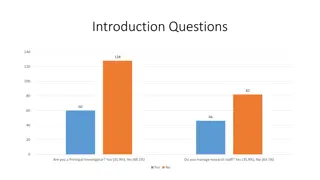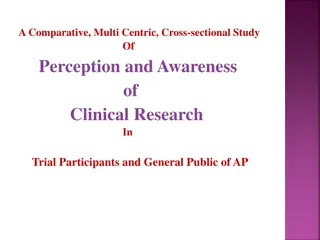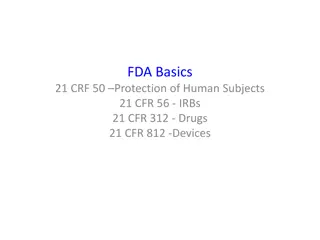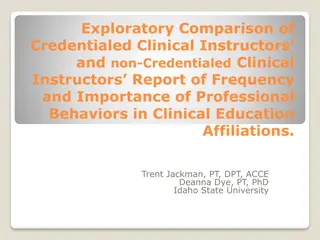Clinical Research Guidelines and Regulations Overview
Clinical research encompasses various guidelines and regulations to ensure the protection of human subjects and the credibility of study results. Key aspects include Good Clinical Practice (GCP) standards, Title 45 of the Code of Federal Regulations (CFR) Part 46, and additional CFR sections for clinical trials. These regulations cover informed consent, electronic records, protection of human subjects, financial disclosure, and institutional review boards. Adherence to these standards is essential for the successful design, conduct, and reporting of clinical trials.
Uploaded on Sep 13, 2024 | 1 Views
Download Presentation

Please find below an Image/Link to download the presentation.
The content on the website is provided AS IS for your information and personal use only. It may not be sold, licensed, or shared on other websites without obtaining consent from the author. Download presentation by click this link. If you encounter any issues during the download, it is possible that the publisher has removed the file from their server.
E N D
Presentation Transcript
ICH E6 Good Clinical Practice Guidance and 45 CFR 46: Protection of Human Subjects CROMS NIDCR National Institute of Dental and Craniofacial Research National Institutes of Health National Institute of Dental and Craniofacial Research C Clinical Research Operations and Management Support Rho, Inc., Federal Division v2.0 - 2013-03-26
Note that this is a general slide presentation designed for a broad audience of clinical researchers. Accordingly, some sections may not apply to your protocol. Information that may not be applicable for all studies is indicated via blue italics. 3
Examples include references to: Investigational Product (IP), the Investigator s Brochure (IB), or a study pharmacist Safety reporting and adverse events Randomization and unblinding procedures Regulatory authorities Clinical treatment (for a behavioral or study or a registry) Information that may be helpful but does not come directly from ICH or 45 CFR 46 is identified by this icon. 4
Good Clinical Practice (GCP) Guidelines (ICH-E6) Widely accepted international research standards Title 45 Code of Federal Regulations (CFR) Part 46 Applies to federally funded research Federal regulations to protect human subjects Subpart A: The Common Rule IRB roles and responsibilities/Informed Consent 5
Additional sections of the Code of Federal Regulations apply to clinical trials 21 CFR 11: Electronic Records/Electronic Signatures 21 CFR 50: Protection of Human Subjects 21 CFR 54: Financial Disclosure by Clinical Investigators 21 CFR 56: Institutional Review Boards Additional Guidance FDA Information Sheets 6
A standard for the design, conduct, performance, monitoring, auditing, recording, analyses, and reporting of clinical trials [studies], that provides assurance that the data and reported results are credible and accurate, and that the rights, integrity, and confidentiality of study subjects are protected. 7
Sets minimum quality standards for the conduct of clinical research Compliance with GCP Ensures that the rights, safety, and well-being of study participants are protected Ensures the integrity of the data submitted for approval Sets standards for a system of mutual accountability among sponsors, regulatory authorities, investigators, and IRBs 8
The regulations and guidelines concerning the establishment of good clinical practice apply to all studies involving human subjects Applies to Interventional studies, including studies without an investigational product Observational studies (specimen collection studies, natural history, etc.) Device studies 9
Specific to research involving human subjects conducted or funded by the DHHS Federal Policy for the Protection of Human Subjects Designed to make uniform human subject protection across all federal agencies and departments 10
Properly qualified to assume responsibility for conduct of the study Thoroughly familiar with the investigational product (IP), and its appropriate use Willing to comply with GCP and applicable regulations and be prepared for audits and monitoring Maintain a Delegation of Responsibilities log 11
Ability to recruit in sufficient numbers and on time Sufficient time to complete the study Adequate number of qualified staff and adequate facilities to complete the study Staff who are well informed about the protocol, the IP, and their study responsibilities 12
Ensure that all trial-related medical decisions are made by an investigator who is a qualified physician Provide adequate medical care for participants who experience adverse events Notify the participant s primary physician of his/her participation (as appropriate) Make an effort to learn why participants withdraw 13
Obtain written approval before the study begins Provide the IRB with the current Investigator s Brochure Provide the IRB/IEC with all documents subject to its review throughout the trial 14
Conduct the trial in compliance with the protocol Deviate only with agreement from the sponsor and prior review/approval from the IRB/IEC There can be exceptions see next slide! Document and explain all deviations 15
The investigator may deviate from the protocol before obtaining agreement from the sponsor and review/approval from the IRB/IEC only: When the changes are logistical/administrative, or To eliminate an immediate hazard to study subjects. This requires immediate submission to: the IRB the sponsor regulatory authorities (if required) 16
Responsible for the product, its usage, and its storage May delegate to a Pharmacist under the PI s supervision Maintain IP records Store as specified by the sponsor and in accordance with applicable regulatory requirement(s) Use IP in accordance with the protocol 17
Follow the study randomization procedures Ensure that the randomization code is only broken in accordance with the protocol Promptly document and notify the sponsor of any unblinding (for blinded trials) 18
Regulations and Guidance ICH 4.8 45 CFR 46 These require the same basic elements of consent. 45 CFR 46 must be followed for research involving human subjects that is conducted, supported, or otherwise subject to regulation by any federal department or agency. 19
Adhere to GCP and the ethical principles that have their origin in the Declaration of Helsinki Update consent document when new information becomes available Avoid: Coercion or undue influence Language that causes the participant to waive any legal rights 20
Fully inform participant of all pertinent aspects of the trial Use lay and non-technical language Should be understandable to the subject 8th grade reading level Translated to native language as applicable (IRB must approve translations) Provide enough time for participant to review the consent document and ask questions 21
The consent document must be signed and dated Obtain consent prior to start of any study-related activities. Initial phone screening can precede consenting. If a participant or representative is unable to read, a witness should be present during the consenting process Provide the participant with a copy of the signed and dated consent form 22
The informed consent discussion and the consent document should include all essential and additional elements Essential elements include: Statement that the study involves research Statement that participation is voluntary Information about purpose, duration, and procedures 23
Essential elements (continued): Number of subjects involved in the study Description of risks, benefits, and alternatives Information about compensation/care for injury Statement regarding confidentiality of records Description of possible unforeseen risks 24
Essential elements (continued): Circumstances for termination without subject consent Consequences of withdrawing from the study Additional costs that may result from participation Statement that new research findings will be shared Contact information for questions/concerns 25
Additional elements from Title 45 CFR 46: Subpart B: Additional protections for pregnant women, human fetuses, and neonates Subpart C: Additional protections for prisoners Subpart D: Additional protections for children 26
Explain the study to the extent it can be understood by participants who can only be enrolled with the consent of a legally acceptable representative (LAR) Follow guidelines for nontherapeutic trials (trials in which there is no anticipated direct clinical benefit to the participant) If participant and LAR can t provide consent, follow measures described in the protocol 27
ICH 4.9 (Records and Reports) ICH 4.10 (Progress Reports) 28
Data must be ALCOA (Accurate, Legible, Contemporaneous, Original, and Attributable) and complete How and where the data is recorded is key! If it is not documented, it does not exist Data on CRFs should match the source documents (raw data) 29
All changes to a CRF must be dated and signed such that the original data is not obscured Retain essential documents for at least 2 years after the last approval of a marketing application Provide monitors, auditors, IRB/IEC, or regulatory authorities with direct access to trial records 30
Record UP/SAE events thoroughly Meets criteria PI to determine causality Follow-up information Make records available to monitors, auditors and inspectors Record retention Institutional requirements ICH GCP 2 years after last approval of marketing application in an ICH region Follow protocol, NIH, and local institutional requirements Longest requirement should be followed 31
Essential Documents Permit evaluation of the conduct of the study and the validity of the data ICH GCP E6 section 8.0 provides a table of essential documents, the purpose of the document, and the location broken down according to the stage of the study Approved documents maintained at centralized location with copies (protocol, MOP) at satellite locations Reviewed for completeness and accuracy 32
Essential Documents (Examples) Investigator of Record (IoR) or 1572 CVs for PI and Sub-Investigators Licenses, as appropriate Training records for all study personnel Protocol / amendment signature page IRB membership list or roster IRB approvals of protocol, consents, ads, handouts Communication with IRB, sponsor, CRO, if applicable 33
Submit a written report at least annually and in accordance with the IRB s request Submit a written report if there are changes that might significantly change the conduct of the trial and/or increase risk to subjects 34
ICH 4.11 (Safety Reporting) ICH 4.12 (Premature Termination or Suspension of a Trial) 35
Immediately report all SAEs to the sponsor; follow-up with a written report EXCEPTION: SAEs identified in protocol as not requiring immediate reporting Identify study participants using codes rather than personal identifiers Comply with applicable regulatory requirement(s) related to the reporting of unexpected serious adverse drug reactions to the regulatory authority(ies) and the IRB/IEC 36
Report AEs and/or lab abnormalities critical to safety evaluations to the sponsor per protocol Provide the sponsor and IRB with additional requested information Autopsy report in the event of a death EKG or other supporting documentation 37
Condition Notify Study terminated/suspended All participants PI terminates study Institution, sponsor, IRB* Sponsor terminates study Institution, IRB* IRB terminates study Institution, sponsor* * Notify in writing 38
At study completion, the investigator should provide: Documentation Provided to Notification of study completion Institution* Summary of the trial s outcome IRB/IEC Any required report(s) Regulatory Authority(ies) *Where applicable 39
Insufficient evidence of Investigator involvement/oversight No documented delegation of responsibility/scope of work Failure to adhere to protocol requirements Inadequate source documents Changes made to original records without audit trail of when, why, by whom Failure to report UPs/SAEs appropriately Participants not signing most current version of consent form Inadequate product accountability records 40
Non-compliance runs the gamut from simple mistakes to fraud. Even simple mistakes can be costly! Consent Specimen handling and processing (labeling, etc.) Consequences can range from: Loss of data (Subject, Site, or Study data considered invalid) Professional/reputational risk for PI and institution 41
Understanding is key to protecting subject safety and integrity of data Monitoring and quality management help ensure compliance Ultimately, it is the PI s responsibility 42
Q&A Resources NIDCR Forms 43
Electronic Code of Federal Regulations http://www.ecfr.gov/cgi-bin/text-idx?c=ecfr&tpl=%2Findex.tpl Office for Human Research Protections (OHRP) http://www.hhs.gov/ohrp/ ICH E6 Guideline http://www.ich.org/fileadmin/Public_Web_Site/ICH_Products/Guidelin es/Efficacy/E6_R1/Step4/E6_R1__Guideline.pdf 45
Objective Objective Resource Resource Protection of human subjects 45 CFR 46 Staff qualifications/training ICH E6, Sec 4.1, Sec 4.2 Research resources ICH E6, Sec 4.2 Protocol adherence ICH E6, Sec 4.5 ICH E6, Sec 4.4.1, Sec 4.9, Sec 8 Record keeping FAQs (OHRP Investigator Responsibilities) http://answers.hhs.gov/ohrp/cat egories/1567 46
NIDCR Investigator of Record Agreement Delegation of Responsibilities Log Training Log Site Screening and Enrollment Log Subject Code List Adverse Event Forms Monitoring Visit Log These forms and other tools are available through NIDCR s Toolkit for Clinical Researchers: http://nidcr.nih.gov/research/toolkit 47
